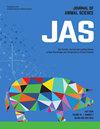PSII-25 Cysteine utilization for liver taurine and intestinal glutathione production is affected by weaning in pigs
IF 2.9
2区 农林科学
Q1 AGRICULTURE, DAIRY & ANIMAL SCIENCE
引用次数: 0
Abstract
Cysteine is a sulfur amino acid with key roles in pig production but how cysteine metabolism and requirements are affected by acute nutritional stress at weaning is unclear. The objective of this study was to determine weaning-induced changes in the abundance and activity of enzymes involved in cysteine utilization in the liver and small intestine. Pigs [initial body weight (BW) = 7.23 ± 0.68 kg] were either weaned at 21 d age and euthanized at 23 d age (W; n = 9) or remained with the sow and euthanized at 23 d age (NW; n = 9). Weaned pigs were fasted to replicate an acute nutritional stress but had free access to water. At euthanasia, liver, jejunum, and ileum tissues were collected. Liver abundance of cysteine dioxygenase 1 (CDO1) and cysteine sulfinic acid decarboxylase (CSAD), enzymes needed for cysteine oxidation to taurine, were determined by immunoblot. Reaction products of GCL and GSS, enzymes needed for glutathione (GSH) production, and CDO1 (liver only) were determined by HPLC. Tissue taurine and GSH concentrations were determined by HPLC. Liver CDO1 activity (0.31 versus 0.52 ± 0.10 nmol cysteine sulfinic acid/mgּ proteinּ min-1); P = 0.14), CDO1 abundance (3.98 versus 7.47 ± 1.96 AU; P = 0.22), and CSAD abundance (1.50 versus 1.54 ± 0.16 AU; P = 0.88) were not different between W and NW pigs. Liver GCL activity (2.49 versus 4.15 ± 0.25 nmol γ-glutamylcysteine/(mgּ proteinּ min-1); P < 0.001) and GSS activity (1.54 versus 1.92 nmol GSH/(mgּ proteinּ min-1); P < 0.001) were less in W compared with NW pigs. Liver taurine concentration increased in W compared with NW pigs (2,250 versus 4,726 ± 471 nmol/g; P < 0.01), whereas liver GSH concentration was not different between W and NW pigs (2,825 versus 2,921 ± 245 nmol/g; P > 0.10). Jejunum GCL activity was not different between W and NW pigs (0.56 versus 0.39 ± 0.07 nmol γ-glutamylcysteine/(mg proteinּ min-1); P = 0.10), whereas GSS activity tended to be lower in W compared with NW pigs (1.11 versus 1.38 ± 0.10 nmol GSH/(mg proteinּ min-1); P = 0.07). Ileum GCL (0.36 versus 0.32 ± 0.07 nmol γ-glutamylcysteine/(mg proteinּ min-1) and GSS activities (1.04 versus 1.02 ± 0.07 nmol GSH/(mg proteinּ min-1) were not different between W and NW pigs (P > 0.10). However, both jejunum (1,379 versus 1,720 ± 70 nmol/g) and ileum (1,497 versus 1,740 ± 74 nmol/g) GSH concentrations were less in W compared with NW pigs (P < 0.05). Despite limited feed intake, liver oxidation of cysteine to taurine was maintained in pigs after weaning. These findings imply that excess endogenous cysteine is oxidized to taurine rather than utilized for gut GSH production.PSII-25 半胱氨酸在肝脏牛磺酸和肠道谷胱甘肽生产中的利用率受猪断奶的影响
半胱氨酸是一种硫氨基酸,在猪的生产中起着关键作用,但半胱氨酸的代谢和需求如何受到断奶时急性营养应激的影响尚不清楚。本研究的目的是确定断奶引起的肝脏和小肠中参与半胱氨酸利用的酶的丰度和活性的变化。猪[初始体重 (BW) = 7.23 ± 0.68 kg]要么在 21 日龄断奶,23 日龄安乐死(W;n = 9),要么留在母猪身边,23 日龄安乐死(NW;n = 9)。断奶猪禁食以模拟急性营养应激,但可自由饮水。安乐死时,收集肝脏、空肠和回肠组织。用免疫印迹法测定肝脏中半胱氨酸氧化成牛磺酸所需的半胱氨酸二氧酶 1(CDO1)和半胱氨酸亚磺酸脱羧酶(CSAD)的含量。通过高效液相色谱法测定谷胱甘肽(GSH)生成所需的酶 GCL 和 GSS 与 CDO1(仅肝脏)的反应产物。组织中的牛磺酸和 GSH 浓度由 HPLC 测定。W 猪和 NW 猪的肝脏 CDO1 活性(0.31 对 0.52 ± 0.10 nmol 半胱氨酸亚硫酸/mgּ蛋白质ּ min-1);P = 0.14)、CDO1 丰度(3.98 对 7.47 ± 1.96 AU;P = 0.22)和 CSAD 丰度(1.50 对 1.54 ± 0.16 AU;P = 0.88)没有差异。W 猪的肝脏 GCL 活性(2.49 对 4.15 ± 0.25 nmol γ-谷氨酰半胱氨酸/(mgּ蛋白质ּ min-1);P < 0.001)和 GSS 活性(1.54 对 1.92 nmol GSH/(mgּ蛋白质ּ min-1);P < 0.001)低于 NW 猪。与西北猪相比,W 型猪的肝脏牛磺酸浓度增加(2,250 对 4,726 ± 471 nmol/g;P < 0.01),而 W 型猪和西北猪的肝脏 GSH 浓度没有差异(2,825 对 2,921 ± 245 nmol/g;P > 0.10)。W 猪和 NW 猪的空肠 GCL 活性没有差异(0.56 对 0.39 ± 0.07 nmol γ-谷氨酰半胱氨酸/(毫克蛋白质ּ-1);P = 0.10),而 W 猪的 GSS 活性往往低于 NW 猪(1.11 对 1.38 ± 0.10 nmol GSH/(毫克蛋白质ּ-1);P = 0.07)。W 猪和 NW 猪的回肠 GCL(0.36 对 0.32 ± 0.07 nmol γ-谷氨酰半胱氨酸/(毫克蛋白质ּ-1)和 GSS 活性(1.04 对 1.02 ± 0.07 nmol GSH/(毫克蛋白质ּ-1))没有差异(P > 0.10)。然而,W 型猪的空肠(1,379 对 1,720 ± 70 nmol/g)和回肠(1,497 对 1,740 ± 74 nmol/g)的 GSH 浓度均低于 NW 型猪(P < 0.05)。尽管采食量有限,但猪在断奶后仍能维持肝脏将半胱氨酸氧化为牛磺酸的过程。这些发现意味着,过量的内源性半胱氨酸被氧化成牛磺酸,而不是用于肠道 GSH 的产生。
本文章由计算机程序翻译,如有差异,请以英文原文为准。
求助全文
约1分钟内获得全文
求助全文
来源期刊

Journal of animal science
农林科学-奶制品与动物科学
CiteScore
4.80
自引率
12.10%
发文量
1589
审稿时长
3 months
期刊介绍:
The Journal of Animal Science (JAS) is the premier journal for animal science and serves as the leading source of new knowledge and perspective in this area. JAS publishes more than 500 fully reviewed research articles, invited reviews, technical notes, and letters to the editor each year.
Articles published in JAS encompass a broad range of research topics in animal production and fundamental aspects of genetics, nutrition, physiology, and preparation and utilization of animal products. Articles typically report research with beef cattle, companion animals, goats, horses, pigs, and sheep; however, studies involving other farm animals, aquatic and wildlife species, and laboratory animal species that address fundamental questions related to livestock and companion animal biology will be considered for publication.
 求助内容:
求助内容: 应助结果提醒方式:
应助结果提醒方式:


